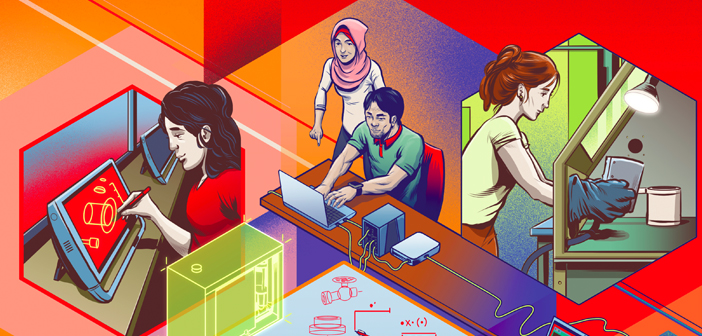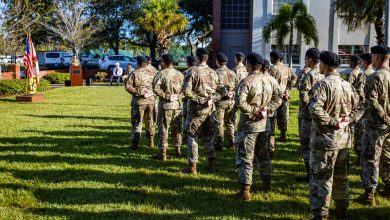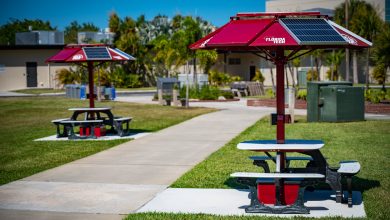The Project Mindset: How Immersive, Hands-On Education Fosters Purpose, Passion and Prosperity
Illustrations by Nicholas Roberts
Doug Bianchi ’15, ’18 MBA, was crushed.
The fish identification mobile app he had developed for his senior design project at Florida Tech, and which he’d been prepping for a commercial launch in the App Store, already existed. His invention wasn’t novel after all.
That was that. For about a week, anyway.
Bianchi dove back in. He took the core concept of his original project and, after about a year of brainstorming, research, prototyping and adjusting based on community feedback, was ready to launch Fish Masters Live, a virtual fishing tournament app for real fishing anytime, anywhere.
What gave Bianchi the resilience, wherewithal and confidence to breathe new life into a venture that had otherwise been dead in the water? Well, he’d done it all before.
“Plan it. Design it. Do it,” Bianchi says. “Senior Design gives you the insight to understand that full spectrum.”
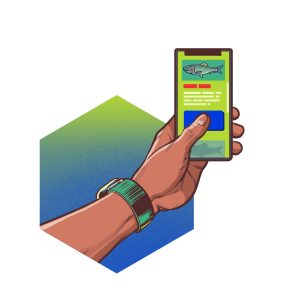 A multidisciplinary capstone project for all science and engineering seniors, senior design is a yearlong course in which students bring a project from concept to completion, simulating a real-world work environment and culminating in the Northrop Grumman Engineering and Science Student Design Showcase, where teams present their work and field questions from peers, faculty, industry professionals and local leaders.
A multidisciplinary capstone project for all science and engineering seniors, senior design is a yearlong course in which students bring a project from concept to completion, simulating a real-world work environment and culminating in the Northrop Grumman Engineering and Science Student Design Showcase, where teams present their work and field questions from peers, faculty, industry professionals and local leaders.
It’s hands-on. It’s engaging. It’s effective.
But to fully ingrain the kind of real-world perspective, strategic planning proficiency and been-there-done-that confidence Bianchi harnessed to make Fish Masters Live a reality, project-based learning starts a lot sooner than senior year. And the goal is a lot bigger than an A-plus.
Molding a Mindset
Fish Masters Live had more than 450 downloads in just the first month and was up to almost 2,500 by mid-May.
“I want it to be big,” Bianchi says.
What’s big?
Downloads? Users? Money?
For Bianchi, it’s a lot more than that.
“Eventually, I want to get to a point where I can start funding projects that can help correct some of the issues that we, as humans, cause and that affect our waters and wildlife,” he says.
While the revenue isn’t quite yet there, Bianchi has already reached out to Florida Tech professors in the hopes that the stream of geolocated, measured and categorized fish images the app garners can contribute to research efforts, particularly in the Indian River Lagoon.
“I think there’s a lot of cool ways to give back or fund researchers,” Bianchi says. “Not everyone’s mindful of that.”
At Florida Tech, this kind of big-picture thinking is encouraged, and in higher education, it has a name: entrepreneurial-minded learning.
Widely promoted by the Kern Entrepreneurial Engineering Network (KEEN), of which Florida Tech has been a member since 2015, entrepreneurial-minded learning takes the more recognized project-based learning principles to another level, adapting traditional, technical instruction to encourage curiosity, develop insight and create value.
“So, it takes something that may just be project-based, but then adds these concepts of fostering creativity and making connections to create value—whether it’s economic or societal or financial value,” says Robert Weaver, ocean engineering associate professor and member of Florida Tech’s KEEN leader team, charged with training faculty to implement entrepreneurial-minded learning concepts in their classrooms.
So, for Weaver, traditional instruction would be lecturing students about how seaports are designed.
Project-based learning would have him ask students to design a seaport themselves.
Entrepreneurial-minded learning, then, requires they analyze their seaport’s feasibility and impact.
“Would someone actually build a port there? What’s the economics behind that? Ports are expensive; how can you justify building that port in a community? What will sustain that facility into the future?” Weaver says. “So, you really have the students focus on that in addition to the logistics.”
While the term “entrepreneurial-minded learning” may be relatively new at Florida Tech, the practice isn’t.
Paul Cosentino, a mechanical and civil engineering professor, has been implementing projects and critical-thinking elements into his courses since he started teaching nearly 40 years ago. While his students are frequently found building balsa wood structures or engineering barium titanate traffic sensors in class, Cosentino doesn’t confine hands-on education to the classroom.
As the faculty advisor for Florida Tech’s American Society of Civil Engineers (ASCE) student chapter, Cosentino oversees a group of about 30 students, who every year, complete 15 major projects, including the renowned concrete canoe competition.
For the competition, members design, construct and race canoes made of concrete. They problem-solve. They collaborate. They learn—and not just about the principles of civil engineering.
“The biggest lesson I learned is that your purpose should always be people. Asking yourself how someone will benefit from what you are doing, what you, yourself, are learning from it or how it might impact others in the future will keep you humble, but also on task,” says Lexi Miller ’15, ’19 M.S., an ASCE alumna and project manager for the City of Satellite Beach. “Nobody gets behind an idea that doesn’t somehow positively impact those around them.”
Lessons like these make a difference, Cosentino says. Having taught at another university less focused on hands-on education, he’s seen that difference.
“I noticed the students’ self esteem, when we weren’t doing this stuff, wasn’t where it should be,” Cosentino says. “It’s super valuable for them to get their confidence by doing things their own way.”
 Especially when that way is applicable to the real world—whether that’s through a documentary published, a strategy implemented or, in the case of Annie Panjwani ’19, a life saved.
Especially when that way is applicable to the real world—whether that’s through a documentary published, a strategy implemented or, in the case of Annie Panjwani ’19, a life saved.
In 2019, Panjwani and her senior design teammates redesigned the user interface for Sun Nuclear Corp.’s water-pumping reservoir used with its 3D scanner to calibrate hospitals’ radiation therapy machines.
While the description is complicated, the results are simple: The machine now services twice as many patients per hour, and Sun Nuclear, a worldwide market leader in radiation oncology quality assurance, rolled out Panjwani and team’s design in August 2019.
“During the process, you learn more than you intended to learn in the first place, and it increased my confidence during that time,” Panjwani says. “It almost felt like an honor that our design actually made it into the company’s new upgrade—they were actually taking ideas from our design, and I think that was a very exciting part.”
The biggest lesson I learned is that your purpose should always be people.
Lexi Miller ’15, ’19 M.S.
Proof in the Product
Projects aren’t just for engineers.
In the Bisk College of Business, instructor Tim Muth’s international business students participate in X-Culture, which groups 5,000-plus students from more than 100 universities in 45 countries into teams tasked with developing business strategies for actual global companies.
In the School of Arts and Communication, Associate Head Heidi Hatfield Edwards and her colleagues have helped students produce countless documentaries, strategic communication plans and published news stories—once even interviewing an astronaut on the International Space Station for a Florida Today series on the health impacts of going to space.
In the College of Aeronautics, professor Debbie Carstens ’96 MBA assisted students in developing an airport runway and corrosion prevention system so impressive, it won the University Design Competition for Addressing Airport Needs from the Transportation Research Board’s Airport Cooperative Research Program.
“It’s really, really hard to do—to craft the right projects,” says Muth, whose freshman Creativity, Innovation and Entrepreneurship course is known on campus for its “Shark Tank” style project that immerses students in experiential learning from day one. “It’s much easier for me to get up there and lecture, but without interaction, they’ll blow right through it.”
The merits of project-based learning are many.
In Muth’s experience, projects teach students to make decisions under pressure and help them to remember and learn from the mistakes they make in the process.
Edwards says that working on a project with real-world practicality results in a sense of ownership and pride that has lasting impacts.
Carstens thinks that, in addition to emphasizing important course concepts, projects develop students’ soft skills, like communication, collaboration and time management.
According to psychology associate professor Julie Costopoulos, such outcomes have been well documented.
A 2014 study published in Proceedings of the National Academy of Sciences (PNAS) found that undergraduate students in classes with traditional stand-and-deliver lectures are 1.5 times more likely to fail than students in classes that use more stimulating, so-called “active learning” methods.
Results from the PNAS study, a meta-analysis of 228 lectures and active-learning strategies, widely favored active learning—so much so that some have questioned the ethicality of continuing to provide lecture-based courses, given their ineffectiveness.
“I feel strongly that project-based learning avoids the passivity of understanding a concept in the abstract,” Costopoulos says. “Instead, the concept has to be understood and correctly applied for the project to be a success. The interest in the end result increases attention, and research supports that increased attention improves retention skills.”
Thanks to ever-evolving technology, this rings particularly true for millennials and their successive “digital native” generations.
According to a study by education consultant and millennial expert Marc Prensky, the technology with which millennials have matured actually wires them to “think and process information fundamentally differently from their predecessors,” making it not “students’ attention capabilities that have changed, but rather their tolerance and needs.”
I feel strongly that project-based learning avoids the passivity of understanding a concept in the abstract. Instead, the concept has to be understood and correctly applied for the project to be a success. The interest in the end result increases attention, and research supports that increased attention improves retention skills.
Julie Costopoulos, associate professor, psychology
Don’t throw away your textbooks and notepads yet, though.
While there is strong evidence supporting the implementation of projects, group work, discussion and other active-learning strategies to improve retention, it doesn’t eradicate the need, in some instances, for traditional lectures, tests and quizzes.
“The theory and background information must still be learned before it can be applied,” Costopoulos says. “And oftentimes, lectures—interactive lectures that engage and involve students—are the most effective way to do that. A subsequent project, then, can put the lesson into context within the real world.”
And while incorporating a senior design-level project into every course may sound exciting and effective, it’s simply not feasible. From full course loads to extracurricular activities to internships, both students’ schedules and mental bandwidths are limited.
Likewise, while juggling their personal and professional responsibilities, professors must ensure that the university has resources—equipment, materials, facilitators—to accommodate every project assigned while mitigating what Costopoulos calls “social loafing”: when a student doesn’t contribute equally to a group project.
“I would say it’s more work, but it’s more delightful work—when balanced,” Costopoulos says.
Fabricating a Future
Perhaps one of the greatest benefits of teaching through usable school projects with practical applications is just that—they’re usable.
Florida Tech alumni like Bianchi, who turn their projects into real-world careers or side hustles, and Panjwani, whose designs are implemented by major corporations, are many.
Unfortunately, the number of those whose projects fizzle out after the deadline is even more.
Tabitha Beavers ’15 attributes this to the “frustration barrier.”
“A lot of people have a really cool idea that’ll just die because they don’t know what to do with it,” Beavers says. “In order to lower that frustration barrier and get people to do their really cool ideas, the first step is knowing what’s possible.”
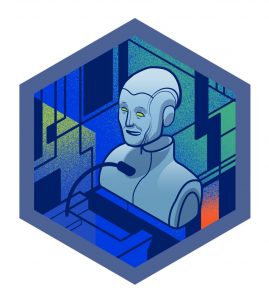 To help them discover those possibilities, she created Space Coast FabLab.
To help them discover those possibilities, she created Space Coast FabLab.
Essentially a community makerspace equipped with the materials and resources necessary to turn concepts into tangible products, Space Coast FabLab was inspired in 2014, when as a student, Beavers shadowed Larry Boyce in the Electronic Support Center on campus.
“Students would bring projects in, and Larry would dig up really cool tech to solve all different problems,” she says. “I learned all the amazingly cool things you could do with really inexpensive pieces of equipment.”
She started the FabLab, then called Project-Based Learning Inc., on Florida Tech’s campus that year with a half-dozen of other students.
Since then, the FabLab has been home to countless projects—an inexpensive prosthetic arm that won the President’s Cup at the 2016 student design showcase; a small multitool that was later manufactured in China and sold in Walmart; and many more—taught community classes, connected makers with local engineers in the industry, hosted hundreds of K-12 field trips and, when it moved to Rockledge, Florida, inspired the creation of Florida Tech’s Makerspace.
“We found mentors for high school students and have had lots of people who got scholarships to go to Florida Tech,” Beavers says. “We’ve had a lot of really cool experiences, and there are a lot of success stories.”
Project-based learning helps people bond on a deeper level and gives them some kind of shared vision to push for.
Tabitha Beavers ’15
One such story is Beavers’ own.
The eye for innovation and ambitious, self-starter spirit she showcased in starting the FabLab while a full-time college student caught the attention of Northrop Grumman Corp.’s director of innovation, who in 2016, hired her to establish internal fabrication labs, or fablabs, at Northrop Grumman campuses across the country.
In just three years, she and her team upstarted five fablabs in Florida and California, not only assembling the resources, but also training staff, setting up high school involvement programs and presenting about the endeavor to company leaders and at major events like the New York Maker Faire.
“It was quite the experience to see how much senior leadership and large companies truly do value the project-based and the hands-on,” Beavers says. “When you’re in a project, whether or not you have grit—the ability to stay mentally fortified, to push for an end—comes out.
Passion. That’s what makes a project.”
This story was featured in the spring 2020 edition of Florida Tech Magazine. Read the full issue here.

